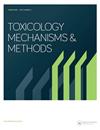染色质分散法检测鸽子红细胞DNA损伤
IF 2.8
4区 医学
Q2 TOXICOLOGY
引用次数: 4
摘要
摘要环境遗传毒性的监测需要选择模式生物作为“哨兵”,并开发敏感可靠的测试方法来评估DNA损伤。本研究的目的是使用改良的染色质分散试验来量化热应激诱导的鹅肝红细胞中基因组DNA链断裂,并通过碱性彗星试验和DNA断裂检测-荧光原位杂交(DBD-FISH)来验证结果。染色质分散度测试可以清楚地观察到有DNA损伤的红细胞和没有DNA损伤的细胞。DNA损伤随着温度的升高而显著增加。此外,我们观察到与细胞凋亡相关的核异常,如核破裂(核崩解)和核溶解(核溶解)。这些结果通过碱性彗星试验和DBD-FISH进行了验证。总之,该方法是一种可靠、准确、廉价的形态学生物测定方法,可用于热应激诱导的鸽子红细胞DNA断裂的常规定量分析。这种方法也可以作为环境保护中基因毒性测试的实用筛选工具。本文章由计算机程序翻译,如有差异,请以英文原文为准。
Detection of DNA damage in pigeon erythrocytes using a chromatin dispersion assay
Abstract The monitoring of environmental genotoxicity requires the selection of model organisms as ‘sentinels’ as well as the development of sensitive and reliable tests for the assessment of DNA damage. The aims of this study were to quantify genomic DNA strand breakage in the erythrocytes of Columba livia induced by thermal stress using the modified chromatin dispersion test and to validate the results by alkaline comet assay and DNA breakage detection–fluorescence in situ hybridization (DBD-FISH). The chromatin dispersion test allowed for clear visualization of erythrocyte cells with DNA damage and of cells with no DNA damage. DNA damage increased significantly with increase in temperature. Additionally, we observed nuclear abnormalities associated with apoptosis, such as karyorrhexis (nuclear disintegration) and karyolysis (nuclear dissolution). These results were validated by alkaline comet assay and DBD-FISH. In conclusion, this procedure is a reliable, precise, and inexpensive morphological bioassay for routine quantitative analysis of DNA breakage in pigeon erythrocytes induced by thermal stress. This method could also be useful as a practical screening tool for genotoxicity testing in environmental care.
求助全文
通过发布文献求助,成功后即可免费获取论文全文。
去求助
来源期刊

Toxicology Mechanisms and Methods
TOXICOLOGY-
自引率
3.10%
发文量
66
期刊介绍:
Toxicology Mechanisms and Methods is a peer-reviewed journal whose aim is twofold. Firstly, the journal contains original research on subjects dealing with the mechanisms by which foreign chemicals cause toxic tissue injury. Chemical substances of interest include industrial compounds, environmental pollutants, hazardous wastes, drugs, pesticides, and chemical warfare agents. The scope of the journal spans from molecular and cellular mechanisms of action to the consideration of mechanistic evidence in establishing regulatory policy.
Secondly, the journal addresses aspects of the development, validation, and application of new and existing laboratory methods, techniques, and equipment. A variety of research methods are discussed, including:
In vivo studies with standard and alternative species
In vitro studies and alternative methodologies
Molecular, biochemical, and cellular techniques
Pharmacokinetics and pharmacodynamics
Mathematical modeling and computer programs
Forensic analyses
Risk assessment
Data collection and analysis.
 求助内容:
求助内容: 应助结果提醒方式:
应助结果提醒方式:


